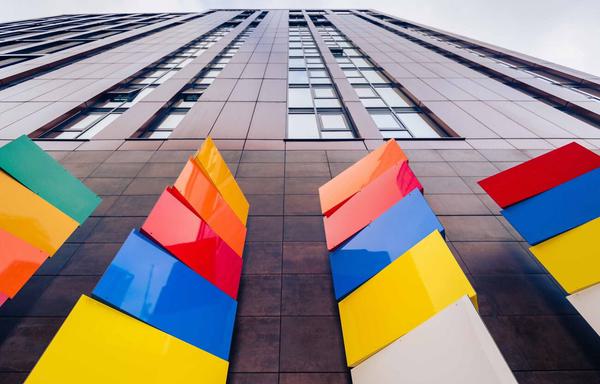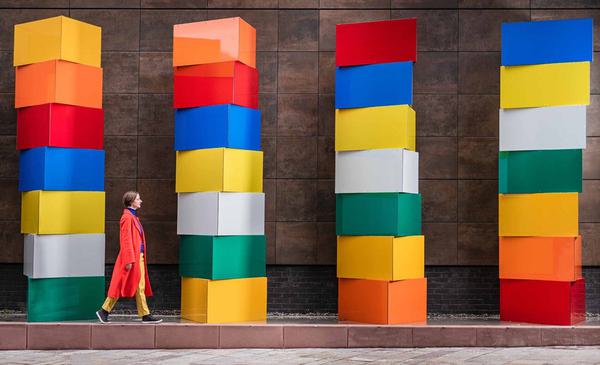Slow Revolution
By
Liz West
2021
Charles Emerson
- Jewellery and Metalwork
- Mixed Media
- Architectural Art
- Installation Art
- Urban Dynamics & Public Realm
- Colour
- Glow
- Revolution
- Tower
- Beacon
- Totem
- Triangle
- Prism
- Reflective
- Environment
- Studio Practice
- Technical / Fabrication
- Project
Dimensions
1600cm (L) x 4000cm (H) x 1200cm (W)
Slow Revolution is a new permanent large-scale sculptural artwork, developed site-specifically for Greengate, Salford. The work comprises of individual prismatic triangles covered in luminescent reflective colours and stacked to form geometric columns, spanning across the building to create an optically vibrant and kaleidoscopic installation. Made of 56 triangular prisms, each set apart at a 5 degree angle, Slow Revolution is a glowing series of 8 towering beacons that appear to playfully twist and rotate as the viewer moves in front of the work, therefore prompting a shifting dialogue between the audience and space. The slow revolution of triangles produces the sensation of gradual movement across the expanse of the sculpture, enlivening its surroundings and encouraging movement through the Greengate corridor.
During the Industrial Revolution, positioned across the River Irwell from Manchester’s cotton mills, were Salford’s dye works which formed a major part of the regions manufacturing landscape. Using industrial and vibrantly coloured materials to pay homage the areas heritage, this monumental work is constructed from steel and aluminium and clothed in swathe of retro-reflecting colour. Retro-reflective material is an unplugged phenomenon made with tens of thousands of tiny glass beads that reflect light and send a focused image directly back to the original light source. Slow Revolution self-illuminates when a direct light source is projected onto the surface of the artwork both in the daytime and in the dark, acting as a multicoloured signpost and vibrant gateway into Salford. Slow Revolution is sited within the confines of the historic Greengate Triangle, an area that dates back to the medieval settlement of Salford. The use of multiple triangular forms within the artwork helps ground the work to its site and references the areas past.
Charles Emerson
Charles Emerson
Charles Emerson
Helping Artists Keep Going
Axis is an artist-led charity supporting contemporary visual artists with resources, connection, and visibility.







